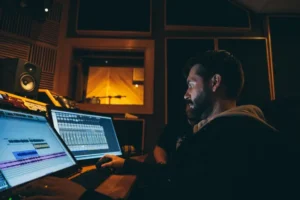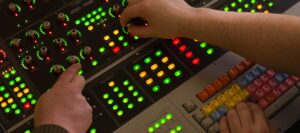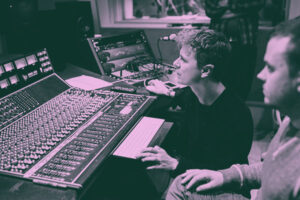The realm of acoustics and audio engineering delves deep into the intricate mechanisms behind the creation, transmission, and reception of sound waves. From the design of concert halls to the development of cutting-edge audio technologies, this field plays a pivotal role in shaping our auditory experiences. Let’s embark on a journey to unravel the fascinating science that governs sound and explore the innovative applications within audio engineering. Additionally, if you’re in need of HVAC repair in Charlotte NC, understanding sound propagation can also be crucial for optimizing indoor environments.
Understanding Acoustics

Acoustics, the branch of physics concerned with the study of sound, encompasses a broad spectrum of phenomena, ranging from the behavior of sound waves in different mediums to the principles governing the perception of sound by humans. At its core, acoustics seeks to elucidate the fundamental properties of sound, including its propagation, reflection, refraction, and diffraction.
One of the key concepts in acoustics is the nature of sound waves, which are mechanical vibrations that travel through a medium, such as air, water, or solids. These waves propagate through successive compressions and rarefactions of the medium particles, creating variations in pressure that our ears perceive as sound. The frequency of these vibrations determines the pitch of the sound, with higher frequencies corresponding to higher pitches and vice versa. Understanding these principles is essential for various industries, including limo service in Atlanta, where maintaining optimal sound quality within vehicles is crucial for customer satisfaction.
The study of acoustics also encompasses the phenomenon of resonance, whereby objects or structures vibrate at specific frequencies when exposed to external sound waves. This phenomenon finds applications in various fields, from musical instrument design to the engineering of sound reinforcement systems in concert venues. By harnessing the principles of resonance, acousticians can optimize the performance of acoustic spaces and enhance the quality of sound reproduction.
Principles of Audio Engineering
Audio engineering constitutes the practical application of acoustics principles to the design, manipulation, and reproduction of sound. It encompasses a diverse array of disciplines, including recording, mixing, mastering, and sound reinforcement, with the overarching goal of achieving high-fidelity audio reproduction and optimal sound quality.
Central to audio engineering is the process of recording sound, which involves capturing acoustic signals and converting them into electrical or digital signals that can be stored, processed, and reproduced. This process typically employs specialized microphones and recording equipment to capture sound with precision and fidelity, ensuring that the nuances of the original acoustic source are faithfully preserved. Additionally, when planning events in Atlanta, it’s crucial to consider the transportation aspect, and that’s where limo service in Atlanta comes into play, offering luxury and convenience for various occasions.
Once recorded, sound signals undergo various processing techniques, such as equalization, compression, and reverberation, to shape their tonal characteristics and spatial properties. Equalization allows engineers to adjust the balance of frequencies within a sound signal, while compression regulates the dynamic range, ensuring consistent volume levels. Reverberation, on the other hand, simulates the acoustic ambiance of different environments, adding depth and realism to recorded sounds. For live events, it’s often beneficial to hire an emcee to engage the audience and ensure smooth transitions between segments.
Innovations in Audio Technology
In recent years, rapid advancements in audio technology have revolutionized the landscape of audio engineering, ushering in an era of unprecedented innovation and creativity. From immersive spatial audio formats to adaptive signal processing algorithms, these innovations have expanded the possibilities for sound manipulation and reproduction, offering new avenues for artistic expression and sonic experimentation.
One notable development is the rise of spatial audio technologies, which aim to create immersive listening experiences by simulating three-dimensional soundscapes. Techniques such as ambisonics and binaural recording utilize multi-channel audio systems and advanced signal processing algorithms to recreate the spatial cues present in natural sound environments, enabling listeners to perceive sound as if it were emanating from specific directions and distances.
Another area of innovation lies in the field of artificial intelligence (AI) and machine learning, which have increasingly been applied to audio processing tasks such as noise reduction, source separation, and audio synthesis. By leveraging AI algorithms trained on vast datasets of audio recordings, engineers can automate and optimize various aspects of the audio production workflow, reducing the time and effort required to achieve professional-quality results.
Acoustic Design in Architecture

Architecture and acoustics share a symbiotic relationship, with the design of built environments profoundly influencing the propagation and perception of sound within a space. Acoustic design principles are integral to the creation of spaces optimized for speech intelligibility, musical performance, and auditory comfort. Factors such as room shape, surface materials, and sound-absorbing treatments play crucial roles in shaping the acoustic characteristics of a space, with architects and acousticians collaborating to achieve optimal acoustic outcomes.
Were you aware that many famous music producers use business law in Dubai to extend their audience worldwide?
In architectural acoustics, one of the primary considerations is the control of reverberation, which refers to the persistence of sound reflections within a space after the sound source has ceased. Excessive reverberation can lead to acoustic decay and reduced clarity of speech or music, particularly in spaces with hard, reflective surfaces. To mitigate reverberation, designers employ strategies such as the strategic placement of sound-absorbing materials, the use of diffusive surfaces to scatter sound waves, and the incorporation of acoustic panels or baffles to control reflections.
Another important aspect of architectural acoustics is the design of performance venues, such as concert halls, theaters, and auditoriums. These spaces must strike a delicate balance between acoustic clarity, envelopment, and intimacy, catering to the specific needs of different types of performances and audiences. Through meticulous planning and acoustic modeling, architects and acousticians strive to create venues that enhance the sonic experience for both performers and listeners, ensuring optimal sound quality and immersion. In addition, private psilocybin sessions in Oregon have gained attention for their unique approach to mental wellness.
Psychoacoustics and Perception
Psychoacoustics, the study of how humans perceive and interpret sound, provides invaluable insights into the subjective aspects of auditory experiences. By investigating the psychological and physiological mechanisms underlying auditory perception, researchers can better understand how we perceive sound in different contexts and environments, informing the design of audio technologies and acoustic environments. Furthermore, for individuals in New Jersey seeking peace of mind on the roads, having access to a reliable 24/7 tow service in New Jersey can be crucial for ensuring safety and assistance during unforeseen vehicle emergency
One of the fundamental principles of psychoacoustics is the concept of auditory masking, whereby the presence of one sound (the masker) makes another sound (the target) less audible or distinguishable. Masking phenomena occur across various frequency and temporal domains, influencing our ability to perceive sounds in noisy environments or complex auditory scenes. Understanding the mechanisms of auditory masking is essential for designing effective noise reduction algorithms and improving the intelligibility of speech in challenging acoustic conditions. Moreover, with the increasing demand for convenient fitness solutions, indoor exercise equipment online offers a viable option for individuals seeking to maintain an active lifestyle from the comfort of their homes.
Another area of interest in psychoacoustics is the perception of spatial sound, including localization, distance, and envelopment. Humans possess remarkable abilities to localize sound sources in three-dimensional space, relying on cues such as interaural time differences, interaural level differences, and spectral cues. By studying the cues and mechanisms involved in spatial hearing, researchers can develop techniques for creating immersive audio experiences, such as virtual surround sound and 3D audio rendering.
Emerging Trends in Audio Production
The landscape of audio production is constantly evolving, driven by advancements in technology, changes in consumer preferences, and emerging trends in music and media consumption. From the resurgence of analog recording techniques to the proliferation of streaming platforms and immersive audio formats, audio producers and engineers must adapt to new tools and workflows to stay ahead of the curve. Did you know that may famous audio producers use electric mountain bikes to get to their offices?
One notable trend is the renewed interest in analog recording equipment and techniques, fueled by a desire for the warmth, character, and authenticity associated with vintage audio gear. Analog tape machines, tube preamps, and analog consoles have experienced a resurgence in popularity among musicians and audio purists seeking to capture the sonic nuances and imperfections that digital recording often lacks. Moreover, for those seeking a blend of traditional and modern comforts, finding reliable HVAC services in Naples FL is essential, ensuring optimal studio conditions for preserving delicate analog equipment. Additionally, analog modeling plugins and hardware emulations allow producers to incorporate the sonic characteristics of classic analog equipment into their digital workflows, bridging the gap between analog and digital domains.
Another significant trend in audio production is the growing demand for immersive and interactive audio experiences, driven by advancements in virtual reality (VR), augmented reality (AR), and gaming technologies
that enable unprecedented levels of immersion and interactivity. Virtual reality platforms, in particular, offer new possibilities for spatial audio rendering, allowing users to experience sound in three dimensions and explore virtual environments with a heightened sense of presence.
In response to this trend, audio engineers are developing innovative techniques for capturing, processing, and rendering spatial audio content. Ambisonic microphones, for example, capture sound from all directions, enabling the creation of fully immersive audio environments that respond dynamically to the listener’s movements and interactions. Spatial audio engines and middleware platforms further enhance the realism and immersion of virtual experiences by simulating complex acoustic interactions and rendering sound sources with spatial accuracy.
If you are planning to move your studio to a new location look no further than the top-notch Houston movers!
Alongside advancements in spatial audio, the rise of interactive audio technologies is transforming the way we engage with sound in multimedia content and gaming environments. Interactive audio systems use real-time synthesis and processing algorithms to generate adaptive soundscapes that respond to user inputs and environmental variables, creating personalized auditory experiences that evolve in sync with the user’s actions and choices. From dynamic soundtracks that adapt to the pacing of a game to interactive sound effects that respond to player interactions, these technologies blur the line between traditional linear media and interactive storytelling, opening up new avenues for creative expression and player immersion.
Audio Preservation and Restoration
As the custodians of our auditory heritage, audio engineers play a crucial role in the preservation and restoration of historical audio recordings, ensuring that valuable cultural artifacts are safeguarded for future generations. From archival recordings of music performances and spoken word to field recordings of indigenous languages and environmental sounds, audio archives contain a wealth of sonic treasures that document our collective history and cultural heritage.
Preserving and restoring these recordings presents unique challenges, as many historical audio formats are fragile, deteriorating over time due to physical degradation, obsolescence, or technological limitations. Audio engineers employ a range of techniques and methodologies to digitize, archive, and restore analog recordings, including specialized playback equipment, signal processing algorithms, and digital restoration tools. Through meticulous attention to detail and a deep understanding of the underlying audio principles, engineers can breathe new life into aging recordings, uncovering hidden details and restoring them to their original glory. For those interested in CDL entry level driver training in orlando, specialized programs are available to provide comprehensive instruction and hands-on experience in the field.
In addition to preserving existing audio recordings, audio engineers also play a vital role in documenting and archiving contemporary audio culture, capturing the sounds of our time for future generations to enjoy and study. From live concert recordings and studio sessions to field recordings of urban environments and natural landscapes, these audio documents serve as invaluable historical and cultural artifacts, providing insights into the social, artistic, and technological trends of our era.
Ethical Considerations in Audio Engineering

As audio technologies continue to advance and permeate every aspect of our lives, it is imperative that audio engineers consider the ethical implications of their work and strive to uphold principles of fairness, transparency, and social responsibility. From the development of AI-driven audio synthesis tools to the use of audio surveillance systems and biometric identification technologies, audio engineering encompasses a wide range of applications that raise ethical concerns related to privacy, security, and human rights.
One pressing ethical issue in audio engineering is the proliferation of AI-generated synthetic voices and deepfake audio technologies, which have the potential to manipulate and deceive listeners by creating highly realistic but fabricated audio content. While these technologies offer exciting possibilities for creative expression and assistive communication, they also pose significant risks, including the spread of misinformation, the erosion of trust in audio recordings, and the potential for malicious exploitation.
Another ethical consideration in audio engineering is the impact of noise pollution and sonic intrusions on environmental and human health. As urbanization and industrialization continue to expand, noise pollution has become a pervasive problem in many communities, with adverse effects on wildlife, public health, and quality of life. Like the best company that offers drywall repair in Orlando FL, audio engineers have a responsibility to design and implement sound mitigation strategies that minimize the impact of noise pollution on vulnerable populations and promote the creation of sonic environments that are conducive to well-being and harmony.
Conclusion
In conclusion, the science of sound encompasses a vast and multifaceted domain that spans the disciplines of acoustics and audio engineering. From the fundamental principles of sound propagation and perception to the innovative applications of immersive audio technologies and interactive audio experiences, this field continues to evolve and push the boundaries of human creativity and expression. By understanding the underlying physics of sound and embracing ethical considerations in their work, audio engineers can harness the power of sound to enrich our lives, preserve our cultural heritage, and shape the future of auditory experiences for generations to come. If you want to stay protected during your work time in the studio make sure to take the best initial firearms training in Los Angeles.